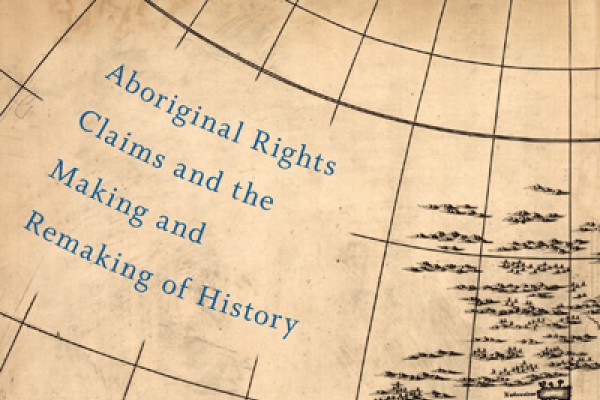Imagining the disappeared
How two novels make clear what public archives of non-fictional testimony cannot show or tell

Chilean mothers of the “disappeared” gather in front of the La Moneda Palace in Santiago, holding signs of their missing loved ones. Photo by Kena Lorenzini/Wikimedia Commons.
“The destruction brought to an end, the job completed, was not told by anyone, just as no one ever returned to describe his own death… We speak in their stead, by proxy.”
—Primo Levi, The Drowned and the Saved
There are extensive bodies of formal testimony about the large-scale human rights atrocities centred in Nona Fernández’s The Twilight Zone (translated by Natasha Wimmer) and Katherena Vermette’s The Break. The mass disappearances that occurred during Augusto Pinochet’s US-backed authoritarian dictatorship, the core of Fernández’s auto-fictional text, are foregrounded in the Report of the Chilean National Commission on Truth and Reconciliation. Similarly, the systemic causes and impacts of misogynistic anti-Indigenous violence in Canada, a central focus of Vermette’s novel, are reflected in Reclaiming Power and Place: The Final Report of the National Inquiry into Missing and Murdered Indigenous Women and Girls.
Both reports combine the voices of, for example, “experts,” activists, survivors, and family members, ultimately recognizing each circumstance of violence as systemic and state-sanctioned to varying degrees (the violence of the Pinochet regime, carried out specifically by his military and secret police; the crisis of missing and murdered Indigenous women enabled, abetted, and sustained by state policies and ideologies that advocate for Indigenous genocide).
Beyond the formal reports, countless other forms of relevant testimony exist, including personal impact testimony and fictional reimaginings like The Twilight Zone and The Break. This testimony, given to police forces, government officials, and lawyers was indispensable to the initiating of the inquiries in the first place.

This category of victim is what Primo Levi, a survivor of the Monowitz labour camp of Auschwitz, calls the “complete witness” (The Drowned and the Saved). In bypassing the expectation to provide unimpeachable objective truth—something that is consistently, and problematically expected of first-person testimony—both novels work to imagine the unimaginable experiences of their “complete witnesses.” In this sense, they highlight the gaps in the current public archives on the Pinochet regime and the MMIW crisis, helping readers recognize what is ultimately and irreconcilably absent from public testimony.
Granted the centrality of “complete witnesses” to events of mass human extermination, Levi’s concept enables a persuasive reading of the fictional testimonies created by Fernández and Vermette as they struggle to convey the inaccessible experiences of their respective disappeared persons: accused leftists, and Indigenous women or girls. In both cases, the unachievable desire to speak with these missing people is embodied in the novels’ meaningful attempts to communicate with the fictional disappeared, so that the texts might, in Levi’s words, “speak in their stead, by proxy.”
On the impossibility of the ‘complete witness’
What had originally connected Levi, Fernández, and Vermette in this author’s mind was their challenge to ongoing issues of anti-socialist neo-fascism in Chile, and global anti-Indigenous and anti-Semitic violence. However, the recent Chilean election brought up another disturbing connection, highlighting the timeliness of the connections between Levi’s, Fernández’s, and Vermette’s works.
In December, socialist president-elect Gabriel Boric beat out right-wing candidate José Antonio Kast, who has famously defended the Pinochet military dictatorship, advocated for the militarization of Chilean Mapuche territory (which is also at the centre of ongoing land claim disputes), and is believed to be the son of a member of the Nazi party. The sinister overlapping of fascist, racist, and imperialist ideologies veiled by Kast’s neoliberalism is not specific to contemporary Chile, but also has relevance in Canadian politics.
While there is still much to be explored in these connections, granted their production of real-world effects, Levi’s, Fernández’s, and Vermette’s focus on the murdered and disappeared—the “complete witnesses”—is a connection worth exploring
For Levi, discussing the ultimate intention of the Third Reich death machine, the “complete witness” is the person who has been rendered no longer alive or human. Although less systematized than the Shoah, the Pinochet regime and the systemic violence experienced by Indigenous women in Canada can also be viewed as intentionally producing “complete witnesses” who are unable to testify against the abuses of the state. In thinking through this concept, Levi distinguishes between the two different forms of “witness” produced during the Shoah:
we, the survivors, are not the true witnesses… we are those who by their prevarications or abilities or good luck did not touch the bottom. Those who did so… have not returned to tell about it… they are… the submerged, the complete witnesses… The destruction brought to an end, the job completed, was not told by anyone, just as no one ever returned to describe his own death… We speak in their stead, by proxy.
Discussing Levi’s concept in Remnants of Auschwitz, political philosopher Giorgio Agamben understands the problem of speaking for the “complete witness” as a paradox:
here the value of testimony lies essentially in what it lacks… The ‘true’ witnesses, the ‘complete witnesses,’ are those who did not bear witness and could not bear witness… The survivors speak in their stead, by proxy, as pseudo-witnesses; they bear witness to a missing testimony… Whoever assumes the charge of bearing witness in their name knows that he or she must bear witness in the name of the impossibility of bearing witness.
At the centre of Holocaust testimony, then, is an acknowledged gap that cannot be filled, because the people whose testimonies are lacking were not allowed to survive. What Levi (and indeed Fernández and Vermette) tries to give voice to is not precisely the words of complete witnesses, but the weight of the gap created by their lack.
As Neil Levi and Michael Rothberg write, imagining the complete witness is not an attempt to “to gain access to that witness’s testimony, but to be compelled to acknowledge the limitations of the testimony we do have.” Levi’s memoirs, as well as Fernández and Vermette’s novels, are not able to recuperate these lost witnesses, or to overcome their loss, but instead they make clear what public archives of non-fictional testimony cannot show or tell.
Imagining the disappeared in The Twilight Zone and The Break
Cauce, a Chilean political magazine published between 1983 and 1989, ran an interview with Andrés Valenzuela, who confessed to torturing people for the Pinochet regime.
The Cauce issue Fernández refers to is real, and in 1984 it publicized the testimony of a member of the Chilean secret police named “Andrés Antonio Valenzuela Morales, Soldier First Class, ID #39432,” referred to in the novel as “the man who tortured people.” From its first pages, The Twilight Zone blurs distinctions between fact and fiction in an attempt to convey the surrealistic liminal “grey space” of torture and disappearance at the core of the Pinochet regime—what it figures as the “twilight zone.”
The novel juxtaposes seemingly autobiographical experiences from Fernández’s life against the narrator’s central project of recuperative imagination: conjuring a “ghostly apparition,” “a sign from beyond the grave,” “A message in a glass bottle tossed into the black sea where all those who ever lived in that dark parallel zone are shipwrecked.” This is all done in attempt to imagine into being the experiences of the disappeared, and, in some cases, a projection of where their souls might be now.
In contrast, The Break comments on the intergenerational trauma of systemic, misogynistic anti-Indigenous violence through its story about the Métis Traverse family, and a chain of events leading to the sexual assault of thirteen-year-old Emily Traverse. Told experimentally through multiple narratorial perspectives, both first and third-person, the novel allows the reader to access Emily’s perspective as well as the perspectives of her many female family members, her best friend, a police officer assigned to the case, and the teenage girl Phoenix who is revealed to be Emily’s attacker. Besides Emily’s best friend, who is Anishinaabe, all the focal characters of the novel are Métis and have grown up around Winnipeg. While Emily’s attack is the central plot of the novel, The Break importantly links this attack—resulting from the anti-Indigenous misogyny internalized by Phoenix, the product of rape—to an earlier, fatal attack on Emily’s great-aunt Rain by an unnamed white man.
What is perhaps the novel’s most experimental aspect is its inclusion of Rain as a first-person narrator after her death. From her perspective as a ghost, Rain sheds light on what is ultimately at stake in the MMIW crisis: the unprosecuted murders and disappearances of Indigenous women, and the subsequent impact on Indigenous families and communities resulting from these losses.

The social expectation that personal testimony achieve perfect objectivity, that objectivity is a requirement for proof of abuse, is a well-acknowledged impediment to prosecution—both on the scale of individual sexual assault and on the scale of state-sanctioned violence. Skepticism of the legitimacy of personal claims has accompanied the attempts for justice around the Shoah, the Pinochet dictatorship, and the interlinked occurrences of violence against Indigenous women—often, if not always, levied by or on behalf of those perpetrating the violence.
This skepticism is also a major focus of the two novels. In The Twilight Zone, the narrator makes plain that the stories of torture victims who have escaped are not given public legitimacy until Valenzuela, himself involved in kidnapping, torture, murder, and body disposal, provides his detailed testimony.
In The Break, we view the major differences between the event resulting in Rain’s death, and the story told about it in the media, as well as the lengthy process of police investigation Emily is put through from her hospital bed. This skepticism, however, is completely circumvented in the fictional imagination-process of both novels where objective “truth” is not an expectation. The fantasized processes of speaking with and through ghosts can persuasively probe into hyperbolized, surrealistic forms of violence like mass-disappearances which are themselves nearly impossible to imagine. How this is done, as well as its effect, is different for both novels.
Fernández’s narrator seeks to communicate the experiences of the disappeared by humanizing them—by imagining life-sustaining thoughts that may have accompanied them during their torture and death. For Communist Party leader José Wiebel Navarrette, kidnapped by “the man who tortured people” while on a bus with his wife and children, the narrator admits that she “[doesn’t] know the details of what unfolded [during his torture].” What she chooses to focus on instead is a fictitious “mental snapshot” she imagines José to have taken of his family before the disappearance. She “wants to believe” this image gave him strength and comfort during his interrogations and eventual murder. She writes:
I imagine José sees this snapshot in his mind’s eye and focuses on it that night at the Cajón del Maipo… José must be blindfolded, his hands bound, and he must be lying on the ground or perhaps standing, facing his executioners. In this last scene in the dark of the mountain night, I imagine the snapshot of the Weibel Barahonas and the sound of the machine gun fire aimed at José’s back or chest.
This imagined process of dying is not, in essence, trying to claim knowledge of José’s last moments. Instead, the narrator’s imagined act restores the humanity to a man whose individuality, drives, and desires have been essentially wiped clean through the act of disappearing him. As well, she forces both herself and readers to imagine what the metaphor of “disappearing” means for these victims. José did not simply cease to exist—he was forcefully removed from the world.
In The Break, Vermette similarly uses a process of humanization to counter the dehumanizing act of Rain’s murder, and the subsequent violence done to her by the local media, who strip her of individuality, misreport the circumstances of her death, and also blame her for her own death.
While Fernández’s narrator primarily imagines the victims during their imprisonment and death, Rain’s narration comes from after her death. She does not comment on the attack or its immediate aftermath, but instead watches over her daughter Stella (Emily’s cousin once-removed) as the family grapples with the attack on Emily. From this distance, Rain articulates the precise physical and emotional experiences that have been stolen from her through her murder: holding her daughter, the feeling of her aging mother’s hands, signs of reciprocated love and care, the knowledge that her life affected others.
Unable to contact Stella directly, Rain communicates with her through the reader: “Whatever else I was, I loved you and you knew it. Your Kookoo[grandmother] knew it too. And you all loved me back. Whatever else you think or know, that is the most important thing about me. That I love and was loved.” Rain the person—a mother, a daughter, a woman—is foregrounded through these passages. While in the world beyond the novel, a survivor’s testimony might articulate the weight of losing someone else, Vermette’s novel articulates the personal loss for the one who doesn’t survive, and whose full, rich life has been reduced by the outside world to the circumstances of her death.
The imaginative role of fiction in archives of testimony
In the context of atrocities so severe that they confound comprehension, novels like Fernández’s and Vermette’s play an indispensable role. They are in living dialogue with existing bodies of non-fictional testimony and formal inquiry reports by imagining the most devastating consequences of their respective violences.
They also force us to recognize an agonizing truth: while the heart-rending survivor testimony available in these reports is integral to understanding the impact of crimes like the Shoah, the Pinochet regime, or the MMIW crisis, the unfillable gap where human life should be is at the centre of these atrocities. The novels, through their desperate imaginings, contain the echo of these lost voices:
Remember who I am, they keep saying.
Remember where I was, remember what was done to me.
Where they killed me, where they buried me.
Sarah Stunden is a writer, researcher, and instructor living in Tiohtìa:ke (Montréal). She earned a PhD in English literature from McGill University (2019), studying non-verbal methods of storytelling in contemporary North American trauma fiction.










